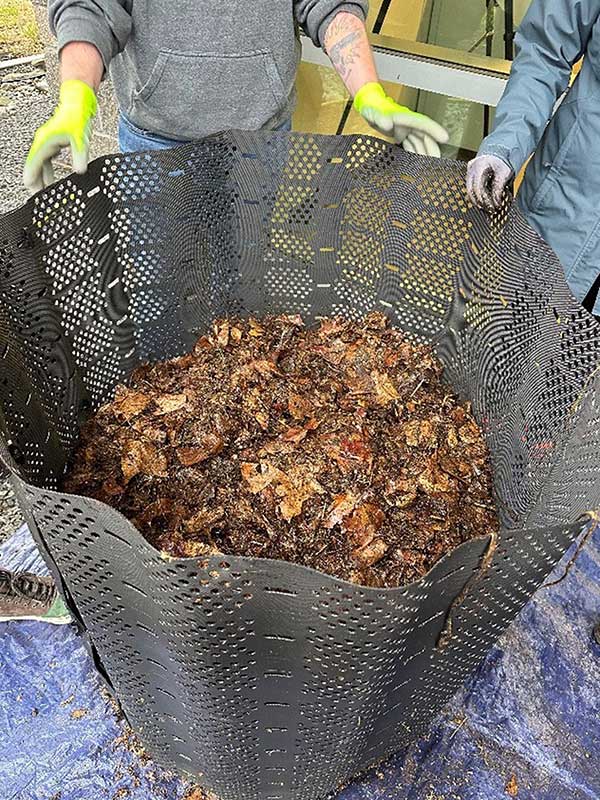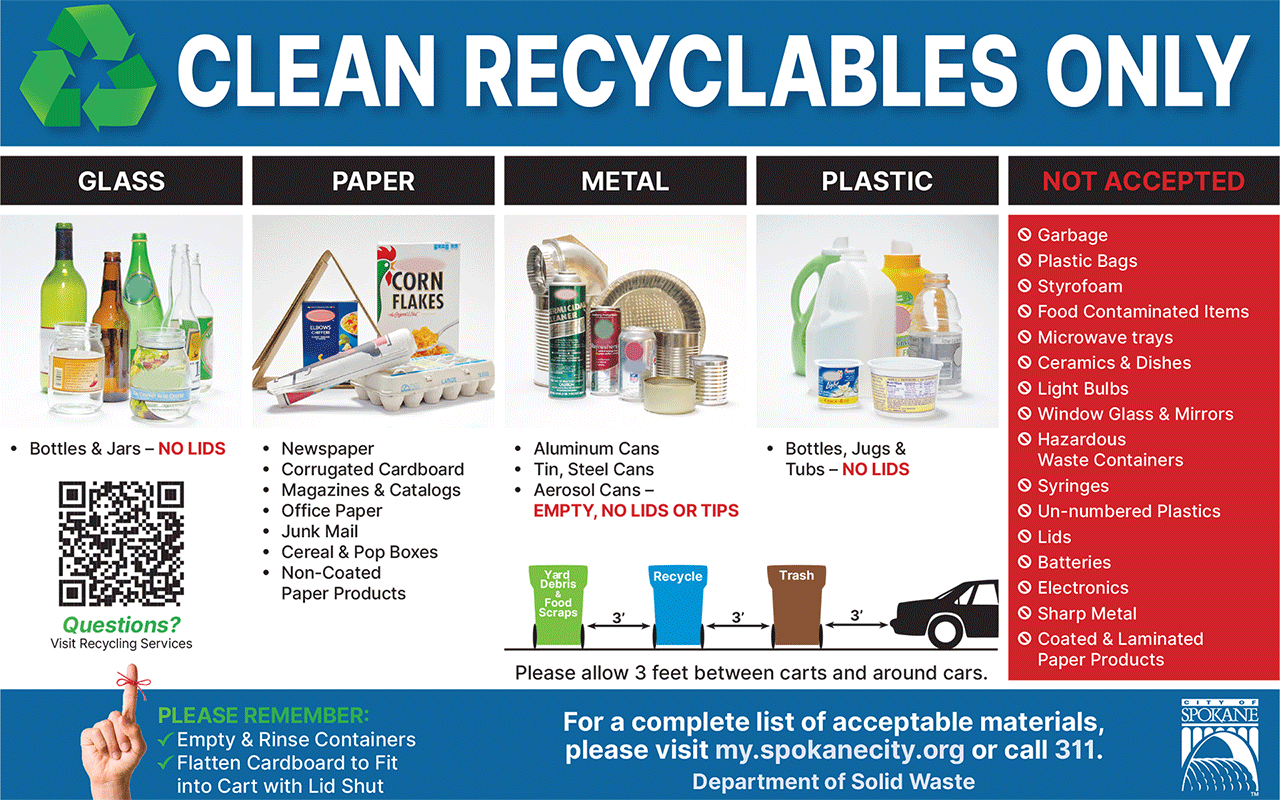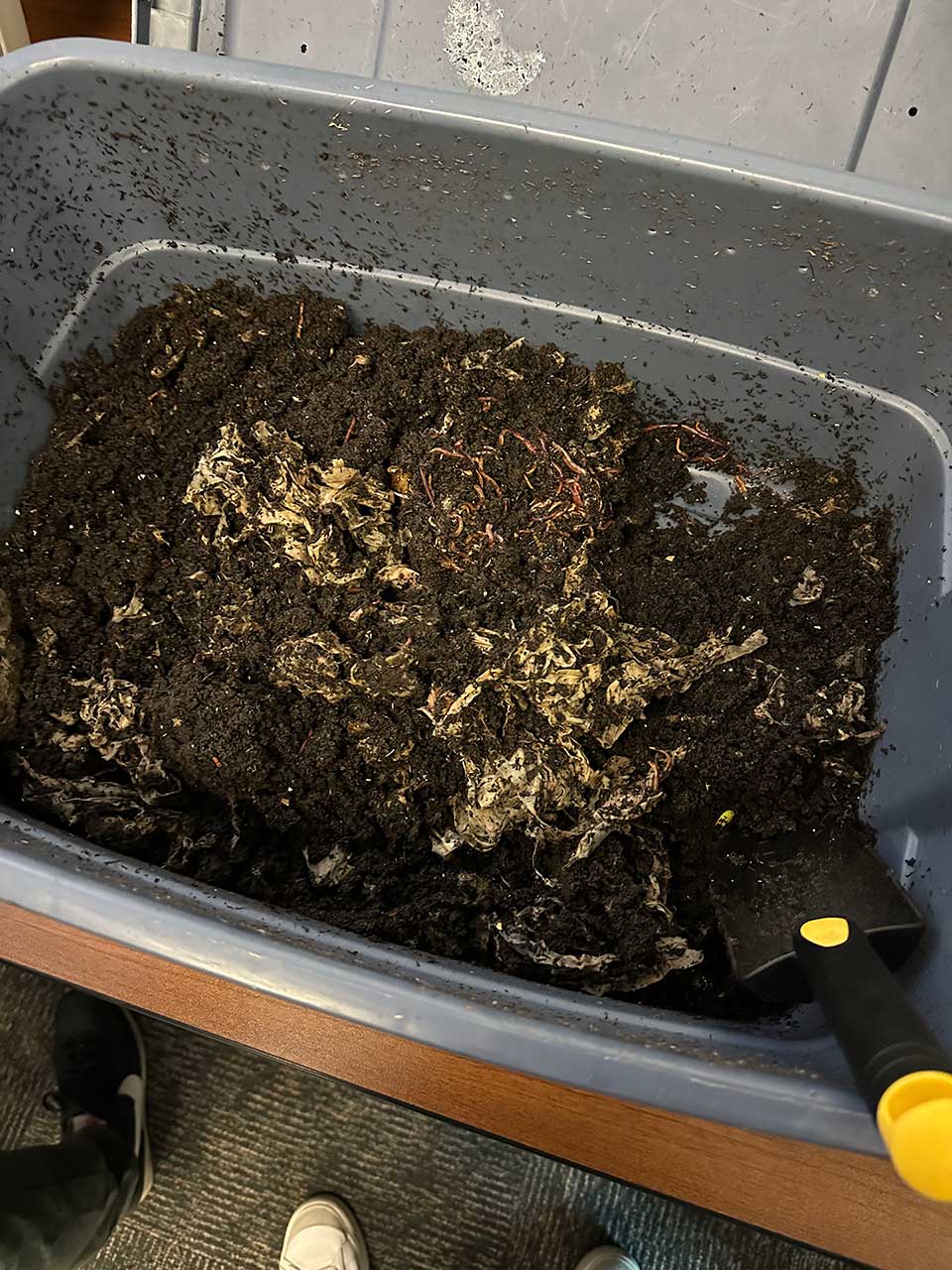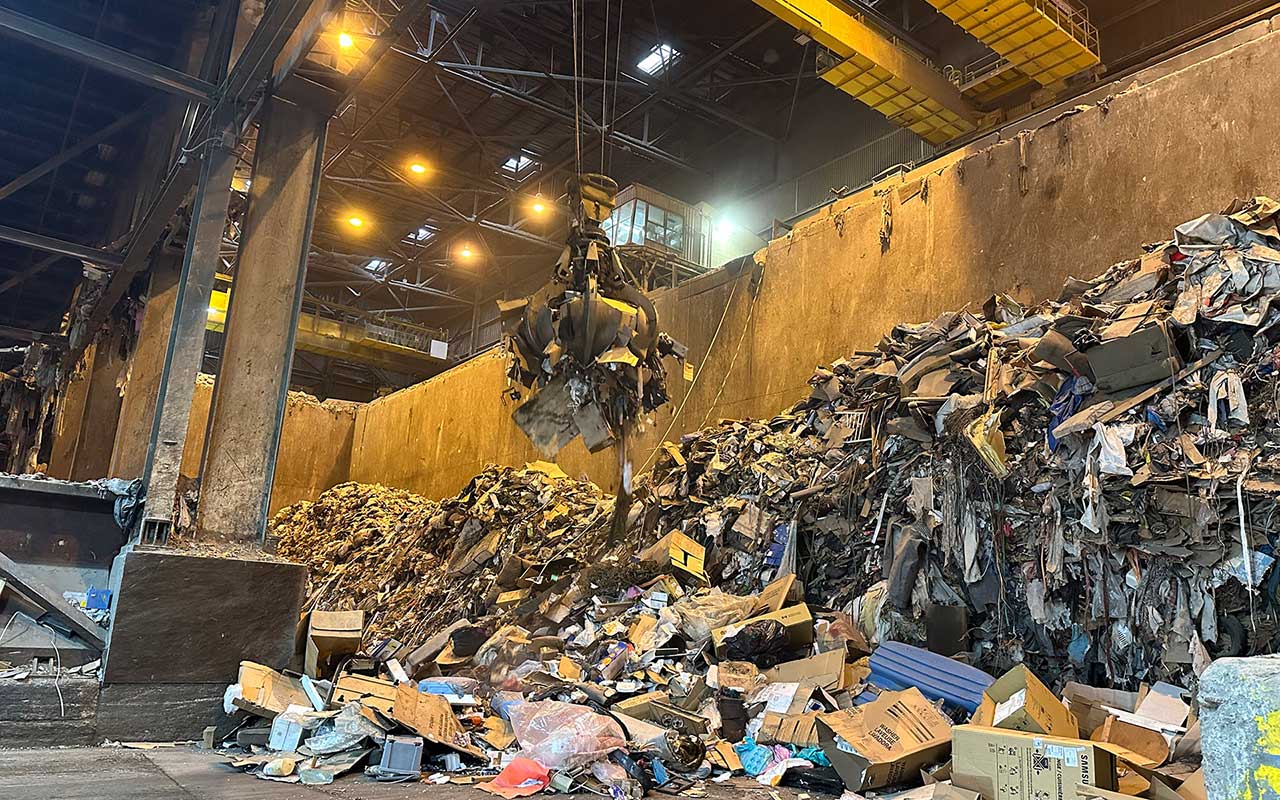
Becoming a Master Composter/Recycler
Jessica Fisher, Public Information Coordinator, 509.625.6749
Friday, March 8, 2024 at 9:58 a.m.

Updated April 24, 2024

Hi everyone! My name is Jessica, and I am becoming a master composter and recycler! Follow along as I take the six-week Master Composter/Recycling course. This free program teaches Spokane County residents how to reduce waste through home composting and recycling.
This blog will be updated weekly, as I attend the six-week program. I will also share updates from volunteering, all Master Composter/Recycler graduates are required to volunteer at least 40 hours.
Follow along!
Class 1
Three takeaways from my first Master Composter/Recycling class!
1. Composting requires food, air, and water.
The three basic ingredients for composting are food, air, and water. Compost calls for blending green material (which is high in nitrogen) and brown material (which is high in carbon). Examples of green materials include kitchen scraps, grass clippings, coffee grounds, and manure. Examples of brown materials include leaves, pine needles, shredded paper, and cardboard. When composting at home you should avoid adding dairy, meat, diseased plants, toxic chemicals, and pet litter to your pile.
Your compost pile needs air. Turning or fluffing your compost pile will keep the bacteria and fungus alive.
Compost should be 45-60% water. You want your compost material to be as wet as a wrung-out sponge. That means you might have to add water your compost pile!
2. Did you know composting involves math?
All organic materials contain carbon and nitrogen. The ideal compost mix is 30:1, or 30 parts carbon to each part nitrogen by weight.
Compost pile example:
- 1 part brown/carbon – dry leaves (60:1)
- 2 parts green/nitrogen – grass clippings (20:1)
Calculating the C:N ratio, tells us the ratio is 33:1, very close to the ideal ratio of 30:1. If you are bad at math like me, I recommend Klickitat County’s online compost mix calculator!
3. Compost is forgiving.
Composting is very forgiving. If you miss a week of adding materials to your compost pile or fail to fluff your pile, no big deal!
At the next Master Composter/Recycler class we will be building our compost pile and learning about the microbiology of compost, compost tea, and an intro to bokashi. Follow along!
Class 2
Week two of the Master Composter/Recycling course was a hands-on class creating a compost pile and learning about compost tea.

On Saturday, our Master Composter/Recycling class had our first hands-on course. During this class, we built two compost piles. Students brought compost material for our compost piles; these materials included leaves, chicken manure, sticks, kitchen scraps, and more. I brought kitchen scraps from curry night!
First, we laid out all the materials on a tarp. Laying the materials out, helped us perfect our compost mix ratio, remember the ideal compost mix is 30:1, or 30 parts carbon to each part nitrogen. After perfecting our ratio, we mixed and wet all the materials before placing them in our compost bins. I was surprised how much we had to water the compost pile! Compost material should be as wet as a wrung-out sponge. As we progress through the Master Composter/Recycling program we will monitor the compost’s progress.
This class also included a lesson and demonstration on compost tea. The benefits of compost tea include increased plant growth, adding nutrients to plants and soil, adding beneficial organisms to plants and soils, and helping prevent disease. The most common compost tea technique is a bucket bubbler; for a how-to brochure on how to make one visit the Spokane County website.
At the next Master Composter/Recycler class we will learn about soil health and recycling in Spokane. Follow along!
Class 3
Time to focus on recycling! Class three was the first time we dove into the recycling portion of the Master Composter/Recycling course.
Recyclables collected in the City of Spokane go to the SMaRT (Spokane Material and Recycling Technology) Center. The SMaRT Center opened in 2012 and allowed Spokane County to switch to a single stream collecting program. This means recyclables from the City of Spokane, City of Spokane Valley, and Spokane County all go to the SMaRT Center. This does not mean the recycling rules are the same!
It is very important to follow your haulers’ recycling rules. Here is the City of Spokane’s list of acceptable materials. This list is also on your blue recycling cart!

Here are some surprising takeaways from the class:
- The numbers on plastic are an identifying code for the type of plastic and don’t mean they are recyclable in Spokane’s system.
- Many items have a recycling symbol, but this does not always mean that the item is recyclable in your region. Check your local haulers’ website to determine if the product is accepted in your container.
- Frozen food boxes and juice concentrate cans are not accepted because they are made with an agent called “wet-strength” that chemically bonds to the cardboard.
- Glass is accepted in the City of Spokane but not window glass. Check your local haulers website to determine if glass bottles and jars are recyclable where you live.
- Lightbulbs are not recyclable! They are accepted as Household Hazardous Waste at the Waste to Energy Facility and the county’s transfer stations.
- Batteries are considered hazardous waste and should not go in the trash. In the City of Spokane, your batteries can be placed in a clear plastic bag and placed on top of your blue recycling cart. They are also accepted at the Waste to Energy Facility and county transfer stations in the Household Hazardous Waste drop-off areas.
- Not a surprise, but a reminder that plastic grocery bags are not recyclable, and no bagged materials should be placed in your blue cart. Recyclables should be loose, clean, and dry.
At the next Master Composter/Recycler class we will learn vermicomposting and bokashi. Follow along!
Class 4
Worms, Worms, Worms! Class four was all about worms and vermicomposting.
Vermicomposting is the use of earthworms to convert organic waste to fertilizer. The best worms for vermicomposting are red wiggler worms because they can eat their weight daily. If you are interested in setting up your own worm composting system here are some tips!

- Make or Purchase a Worm Bin
Worm bins should be shallow because red wiggler worms tend to be surface feeders. The bins also need ventilation so the worms can breathe! When looking for a place to keep the bin, consider worms' preferred temperature is 55-77 degrees and that they do not like loud noises or vibrations. - Add Bedding & Grit
Fill about half of the worm bin with bedding. Good worm bedding can be shredded newspaper, shredded corrugated cardboard, peat moss, leaf mold, or a combination of these materials. Your bedding should be moist! Also, add some grit like a bit of soil or fine sand, to help the worms break down the food. - Add Worms
Place the worms on top of the bedding. Keep a bright light close by so the worms disappear faster into the bedding. - Feed the Worms
Feed the worms regularly. Worms will eat vegetable and fruit scraps, crushed eggshells, spoiled food from the fridge, coffee grounds, and tea bags. Put the food in a different area of the bin each time you feed the worms.
Avoid feeding worms fats, meat, bones, fish, dairy products, onion, garlic, and citrus. - Harvest Your Compost
The easiest way to harvest worm castings (compost) is:- Remove the lid.
- Move all the worm bin contents to one side of the bin.
- Add fresh, moist bedding and food to the other side and cover with a plastic sheet. Worms prefer darkness so they will naturally migrate to the fresh material.
- Remove the castings.
- Use the castings as a top dressing for houseplants and seedlings, for general garden use, or the preparation of compost tea.
At the next Master Composter/Recycler class we will be touring the City of Spokane’s Waste to Energy Facility. Follow along!
Class 5

The claw! During our fifth Master Composter/Recycling class we saw the claw in person during our Waste to Energy Facility tour.
The Waste to Energy Facility opened in 1991, as part of a solution to handle the community's garbage and leaking landfills. The facility burns 800 tons of garbage daily at 2500 degrees and reduces waste by 90%. All while the heat from the boiler generates 22 megawatts of electricity, enough to power 13,000 homes.
Here are some fun facts from the Waste to Energy Facility tour:
- While the facility is owned by the City, Spokane County sends its garbage there too.
- The garbage pit is 40 feet deep and 150 feet wide and can hold up to 4,800 tons of garbage.
- The facility has two boilers that burn 800 tons of garbage every day.
- The City of Spokane sells the electricity it generates to Avista Utilities.
- The plume you see from the stack is water vapor.
If you are interested in touring the Waste to Energy Facility the City of Spokane does provide free group tours.
At the next Master Composter/Recycler class we will learn about bokashi. Follow along!
Class 6
At our last Master Composter/Recycler class we learned about bokashi bins and prepared for the upcoming Arbor Day Celebration and Spring Compost Fair!
Bokashi originated in Japan and is a composting method that ferments organic matter. This method is perfect for recycling food scraps in apartments, schools, or workplaces without access to an outdoor space. Unlike traditional composting, bokashi has no food scrap limitations. You can put meat, dairy, fish, and food scraps high in protein, fats, or oils in your bokashi bin. If you are interested in setting up your own bokashi bin here are some tips.
Add Food Waste
All of your food waste can go into your bokashi bin, even bones!
Mix in Bokashi Bran
Sprinkle your food scraps with bokashi bran. Repeat these steps until your bokashi bin is full. Once the bin is full, seal the lid and leave the bin for two weeks to complete the fermentation process.
Add to Garden
You can bury your compost directly in your garden beds, compost pile, or potting containers.
If you are interested in building your own bokashi a free class is available on the City of Spokane’s Learn Worlds platform.
Join my Master Composter/Recycler class at the upcoming Arbor Day Celebration and Spring Compost Fair on Saturday, April 27, from 11 a.m. to 2 p.m. at Finch Arboretum. Participants who live within Spokane County can receive a free compost bin after completing the composting activity stations. Bins are limited to one per household. Proof of residence is required, and supplies are limited. Bins are provided in part through a grant with the Washington State Department of Ecology. See you there!
More About...
- Composting
- Composting Class
- Environment
- Food Scraps
- Food Waste
- Garden
- Gardening
- Home Grown
- Master Composter/Recycler Program
- Organic Waste
- Planting
- Plants
- Recycling
- Recycling Class
- Spokane
- YARD
